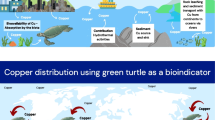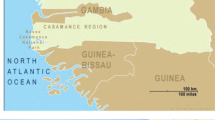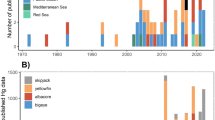Abstract
Mercury is a trace element that is potentially dangerous due its high toxicity and tendency to bioaccumulate in organisms. Currently, high mercury concentrations are seen in the environment especially due climate changes. Studies regarding mercury bioavailability in the southwestern Atlantic Ocean using tuna and tuna-like species are rare. The aim of the present study was to use tuna and tuna-like species (Thunnus atlanticus, Thunnus albacares, Katsuwonus pelamis, Euthynnus alletteratus, Coryphaena hippurus and Sarda sarda) as indicators of the availability of total mercury (THg) in oceanic food webs of the southwestern Atlantic Ocean. THg concentrations varied significantly among species for both muscle and liver (Kruskal–Wallis test; H5,130 = 52.7; p < 0.05; H5,130 = 50.1; p < 0.05, respectively). The lowest concentrations were found in C. hippurus (0.008 mg kg−1 wet weight in the muscle and 0.003 mg kg−1 wet weight in the liver), and the highest concentrations were reported in the muscle of T. atlanticus (1.3 mg kg−1 wet weight) and in the liver of S. sarda (2.5 mg kg−1 wet weight). The continued monitoring of tuna and tuna-like species is necessary to assist in their conservation since tuna can be sentinels of mercury pollution.




Similar content being viewed by others
References
Adams DH (2004) Total mercury levels in tunas from offshore waters of the Florida Atlantic Coast. Mar Pollut Bull 49:659–663
Adams DH (2009) Consistently low mercury concentrations in dolphinfish, Coryphaena hippurus, An Oceanic Pelagic Predator. Environ Res 109:697–701
ATSDR (Agency for Toxic Substances and Disease Registry) (1999) Toxicological Profile for Mercury. Department of Health and Human Services, Public Health Service, Atlanta, p 617
Avenant-Oldewage A, Marx HM (2000) Bioaccumulation of chromium, copper and iron in the organs and tissues of Clarias gariepinusin the Olifants River, Kruger National Park. Water SA 26:569–582
Bastos WR, Malm O, Pfeiffer WC, Cleary D (1998) Establishment and analytical quality control of laboratories for hg determination in biological and geological samples in The Amazon. Brasil Ci e Cult 50:255–260
Bisi T, Lepoint G, Azevedo A, Dorneles P, Flach L, Das K, Malm O, Lailson-Brito J (2012) Trophic relationships and mercury biomagnification in Brazilian tropical coastal food webs. Ecol Indic 18:291–302
Booth S, Zeller D (2005) Mercury, Food webs, and marine mammals: implications of diet and climate change for human health. Environ Health Perspect 113:521–526
Bosch AC, O’Neill B, Sigge GO, Kerwath SE, Louwrens CH (2016) Mercury accumulation in Yellowfin tuna (Thunnus albacares) with regards to muscle type, muscle position and fish size. Food Chem 190:351–356
Burger J, Gochfeld M (2011) Mercury and selenium levels in 19 species of saltwater fish from New Jersey as a function of species, size and season. Sci Total Environ 409:1418–1429
Burger J, Gaines KF, Boring CS, Stephens WL, Snodgrass J, Gochfeld M (2001) Mercury and selenium in fish from the Savannah River: species, trophic level, and locational differences. Environ Res 87:108–118
Cai Y, Rooker JR, Gill G (2006) Bioaccumulation of mercury in pelagic fishes in NW Gulf of Mexico and its relationship with length, location, collection year, and trophic level. GCFI. 57:317–326
Cai Y, Rooker JR, Gill GA, Turner JP (2007) Bioaccumulation of mercury in pelagic fishes from the northern Gulf of Mexico. Can J Fish Aquat Sci 64:458–469
Campo D, Mostarda E, Castriota L, Scarabello MP, Andaloro F (2006) Feeding habits of the atlantic bonito, Sarda sarda (Bloch, 1793) in the southern Tyrrhenian Sea. Fish Res 81:169–175
Carty AJ, Malone SF (1979) The chemistry of mercury in biological systems. In: Nriagu JO (ed) Biogeochemistry of mercury in the environment. Elsevier/North-Holland Biomedical Press, Amsterdam, pp 433–479
Choy CA, Poppb BN, Kanekoc JJ, Drazena JC (2009) The influence of depth on mercury levels in pelagic fishes and their prey. PNAS. 106:13865–13869
Collette BB, Nauen CE (1983) Scombrids of the world. An annotated and illustrated catalogue of tunas, mackerels, bonitos and related species known to date, 2nd edn. Rome, Italy, p 137
Croizier G, Schaal G, Point D, Le Loc’h F, Machu E, Fall M, Munaron J, Boyé P, Walter P, Laë R, Morais LT (2019) Stable isotope analyses revealed the influence of foraging habitat on mercury accumulation in tropical coastal marine fish. Sci. Tot Environ 650:2129–2140
Downs SG, MacLeod CL, Lester JN (1998) Mercury in precipitation and its relation to bioaccumulation in fish: a literature review. Water Air Soil Pollut 108:149–187
Drevnick PE, Lamborg CH, Horgan MJ (2015) Increase in mercury in Pacific yellowfin tuna. Environ Toxicol Chem 34–4:931–934
Endo T, Kimura O, Fujii Y, Haraguchi K (2016) Relationship between mercury, organochlorine compounds and stable isotope ratios of carbon and nitrogen in yellowfin tuna (Thunnus albacares) taken from different regions of the Pacific and Indian Oceans. Ecol Indic 69:340–347
FAO (1994) Food and Agriculture Organization. World review of highly migratory species and straddling stocks. Fao Fisheries Technical Paper 337. Food and Agricultural Organization, p 70
FAO, 1997. Food and Agriculture Organization. Review of the state of world fishery Resources: Marine Fisheries (English). Special Topics. Global resources of tuna and tuna-like species. In: Fao Fisheries Circular (FAO), No. 920 / Fao, Rome (Italy). Fishery Resources Division, pp. 177
Fenton J, Ellis JM, Falterman B, Kerstetter DW (2014) Habitat utilization of Blackfin Tuna, Thunnus atlanticus, in the North-Central Gulf of Mexico. Environ Biol Fish 98:1147–1150. https://doi.org/10.1007/s10641-014-0347-3
Ferreira S, Mársico ET, Nepomuceno A, Junior M, Mano SB (2012) Mercúrio total em pescado marinho do Brasil. Rev Bras Med Vet 19:50–58
Fitzgerald WF, Clarckson TW (1991) Mercury and monomethylmercury: present and future concerns. Environ Health Perspect 96:159–166
Fitzgerald WF, Mason RP (1997) Biogeochemical cycling of mercury in the marine environment. In: Sigel A, Sigel H (eds) Metal Ions in Biological Systems, vol. 34. Marcel Dekker, New York, pp 53–111
Fletcher N, Batjakas IE, Pierce GJ (2013) Diet of the Atlantic Bonito Sarda sarda (Bloch, 1793) in the northeast Aegean Sea. J Appl Ichthyol 29:1030–1035
Fonteneau, A., Soubrier, P., (1996). Interactions between tuna fisheries: a global review with specific examples from the Atlantic Ocean. FAO Fisheries Technical Paper, p. 84–123
García CB, Posada C (2013) Diet and feeding ecology of the little tunny, Euthynnus alletteratus (Pisces: Scombridae) in the central Colombian Caribbean: changes in 18 years. Lat Am J Aquat Res 41:588–594. https://doi.org/10.3856/vol41-issue3-fulltext-21
Goldstein RM, Bringham ME, Stauffer JC (1996) Comparison of mercury concentrations in liver, muscle, whole bodies, and composites of fish from the Red River of the North. Can J Fish Aquat Sci 53:244–252
Gray JS (2002) Biomagnification in marine systems: the perspective of an ecologist. Mar Pollut Bull 45:46–52
Hajeb P, Jinap S, Ahmad I (2010) Biomagnification of mercury and methylmercury in tuna and mackerel. Environ Monit Assess 171:205–217
Hall RA, Zook EG, Meaburn GM (1978) National marine fisheries service survey of trace elements in the fishery resource. NOAA Technical Report NMFS SSRF 721:313
Headley BM, Oxenford HA, Peterson MS, Fanning P (2009) Size related variability in the summer diet of the Blackfin Tuna (Thunnus atlanticus, Lesson, 1831) from Tobago, The Lesser Antilles. J Appl Ichthyol 25:669–675
ICCAT (1994) Sctruture de stock de l’albacore (Thunnus albacares) atlantique de aprés les marquages compares aux lieux de ponte. Col.Vol.Sci.Pap. 42:204–208
ICCAT, 2010. ICCAT Manual, Chapter 2.1.3 Skipjack Tuna, pp. 22
International Union for Conservation of Nature (IUCN) (2011). The IUCN Red List For Threatened Species. http://www.iucnredlist.org/ (accessed in June 25Th, 2019) https://doi.org/10.2305/IUCN.UK.2011-2.RLTS.T21857A9327139.en
Juan-Jordá MJ, Mosqueira I, Cooper AB, Freire J, Dulvy NK (2011) Global population trajectories of tunas and their relatives. Proc Natl Acad Sci 108:20650–20655
Kojadinovic J, Potier M, Le Corre M, Cosson R, Bustamante P (2006) Mercury Content In Commercial Pelagic Fish And Its Risk Assessment In The Western Indian Ocean. Sci Total Environ 366:688–700
Kojadinovic J, Potier M, Le Corre M, Cosson R, Bustamante P (2007) Bioaccumulation of trace elements in pelagic fish from the Western Indian Ocean. Environ Pollut 146:548–566
Krabbenhoft DO, Sunderland EM (2013) Global change and mercury. Science 341:1457–1458
Kraepiel AM, Keller K, Chin HB, Malcolm EG, Morel FM (2003) Sources and variations of mercury in tuna. Environ Sci Technol 37(24):5551–5558
Kuklyte L, Rowe G (2012) Mercury contamination in pelagic fishes of the Gulf of Mexico. Atiner’s Conference Paper Series. Env 2012, 0366
Lamborg CH, Hammerschmidt CR, Bowman KL, Swarr GJ, Munson KM, Ohnemus DO, Lam PJ, Heimbürger L, Rijkenberg MJA, Saito MA (2014) A global ocean inventory of anthropogenic mercury based on water column measurements. Nature 512:65–69
Licata P, Trombetta D, Cristani M, Naccari C, Martino D, Calo M (2005) Heavy metals in liver and muscle of Bluefin Tuna (Thunnus thynnus) caught in the straits of Messina (Sicily, Italy). Environ Monit Assess 107:239–248
Malm O (1989) Utilização do acessório de vapor frio para investigação de mercúrio em amostras ambientais por espectrofometria de absorção atômica. Cienc Cult 41:88–92
Mason RP, Fitzgerald WF (1990) Alkylmercury species in the equatorial Pacific. Nature 347:451–459
Mason RP, Fitzgerald WF (1991) The distribution and biogeochemical cycling of mercury in the equatorial Pacific Ocean. Deep-Sea Res I Oceanogr Res Pap 40:1924–1993
Mason RP, Fitzgerald WF (1993) The distribution and biogeochemical cycling of mercury in the Equatorial Pacific Ocean. Deep-Sea Res I Oceanogr Res Pap 40:1897–1924
Mason RP, Sheu GR (2002) Role of the ocean in the global mercury cycle. Glob Biogeochem Cycles 16:4001–4014
Mason RP, Sullivan K (1999) A. Mercury in the South and Equatorial Atlantic. Deep-Sea Res II Top Stud Oceanogr 46:937–956
Medeiros RJ, Mársico ET, São Clemente SC, Ferreira MS (2008) Distribuição do metal mercúrio em atum (Thunnus albacares) e pescada bicuda (Cynoscion microlepidotus) capturados no litoral do Rio de Janeiro. Brasil Arq Bras Med Vet Zoo 60:656–662
Menezes NA, Figueiredo JL (2000) Manual De Peixes Marinhos Do Sudeste Do Brasil, Teleostei, 5th edn. Museu De Zoologia, São Paulo, p 90
Monteiro LR, Costa V, Furness RW, Santos RS (1996) Mercury concentrations in prey fish indicate enhanced bioaccumulation in mesopelagic environments. Mar Ecol Progr 141:21–25
Morel FMM, Kraepiel AML, Amyot M (1998) The chemical cycle and bioaccumulation of mercury. Annu Rev EcolEvol Syst 29:543–556
Ordiano-Flores A, Rosíles-Martínez R, Galván-Maganã F (2012) Biomagnification of mercury and its antagonistic interaction with selenium in yellowfin tuna Thunnus albacares in the trophic web of Baja California Sur, Mexico. Ecotoxicol Environ Saf 86:182–187
Oxenford HA (1999) Biology of the dolphinfish (Coryphaena hippurus) in the Western Central Atlantic : a review. Sci Mar 63:277–301
Oxenford HA, Hunte W (1999) Feeding habits of the dolphinfish (Coryphaena hippurus) in the Eastern Caribbean. Sci Mar 63:303–315
Peterson CL, Klawe WL, Sharp GD (1973) Mercury in tunas: a review. Fish Bull 71:3
Santos RA, Haimovici M (2002) Cephalopods in the trophic relations off Southern Brazil. Bull Mar Sci 71(2):753–770
Selanes AG, Mársico ET, Santos NN, São Clemente SC, Oliveira GA, Monteiro ABS (2002) Mercúrio em peixes marinhos. Acta Sci Vet 30(2):107–112
Senn DS, Chesney EJ, Blum JD, Bank MS, Maage A, Shine JP (2010) Stable isotope (N, C, Hg) study of methylmercury sources and trophic transfer in the Northern Gulf of Mexico. Environ Sci Technol 44:1630–1637
Sharma CM, Borgstrom R, Huitfeldt JS, Rosseland BO (2008) selective exploitation of large pike Esox Lucius- effects on mercury concentrations in fish populations. Sci Total Environ 399(1–3):33–40
Silva CA, Tessier E, Kütter VT, Wasserman JC, Donard OFX, Silva-Filho EV (2011) Mercury speciation in fish of the Cabo Frio Upwelling Region, Se - Brazil. Braz J Oceanogr 59(3):259–266
Storelli MM, Giacominelli-Stuffler R, Marcotrigiano GO (2001) Total mercury and methylmercury in tuna fish and sharks from the South Adriartic Sea. IJFS 13:103–108
Storelli MM, Stuffler RG, Marcotrigiano GO (2002) Total and methylmercury residues in tuna-fish from the Mediterranean Sea. Food Addit Contam 18:715–720
Storelli MM, Giacominelli-Stuffler R, Storelli A, Marcotrigiano GO (2005) Accumulation of mercury, cadmium, lead and arsenic in swordfish and bluefin tuna from the Mediterranean Sea: a comparative study. Mar Pollut Bull 50(9):1004–1007
Sunderland EM, Mason RP (2007) Human impacts on open ocean mercury concentrations. Glob Biogeochem Cycles 21(GB402):1–15
Sunderland EM, Krabbenhoft DP, Moreau JW, Strode SA, Landing WM (2009) Mercury sources, distribution, and bioavailability in the North Pacific Ocean: insights from data 233 and models. Glob Biogeochem Cycles 23–2:1–14
Trudel M, Rasmussen JB (1997) Modeling the elimination of mercury by fish. Environ Sci Technol 31:1716–1722
Trudel M, Rasmussen JB (2006) Bioenergetics and mercury dynamics in fish: a modeling perspective. Can J Fish Aquat Sci 63:1890–1902
Ueno D, Takahashi H, Tanaka A, Subramanian N, Fillmann G, Nakata H, Lam KS, Zheng J, Muchtar M, Prudente M, Chung KH, Tanabe S (2003) Global pollution monitoring of PCBs and organochlorine pesticides using skipjack tuna as a bioindicator. Arch Environ Contam Toxicol 45:378–389
Vaske-Júnior T, Castello JP (1998) Conteúdo estomacal da albacora-laje, Thunnus albacares, durante o inverno e primavera no Sul do Brasil. Rev Bras Biol 58(4):639–647
Voegborlo RB, Matsuyama A, Akagi H, Adimado AA, Ephraim JH (2006) Total mercury and methylmercury accumulation in the muscle tissue of frigate (Auxis thazard thazard) and yellow fin (Thunnus albacares) tuna from the Gulf of Guinea. Ghana Bull Environ Contam Toxicol 76(5):840–847
Wang W (2002) Interactions of trace metals and different marine food chains. Mar Ecol Prog Ser 243:295–309
Yamashita Y, Omura Y, Okazaki E (2005) Total mercury and methylmercury levels in commercially important fishes In Japan. Fish Sci 71(5):1029–1035
Zagaglia CR, Lorenzzetti JA, Stech JL (2004) Remote sensing data and longline catches of yellowfin tuna (Thunnus albacares) in the Equatorial Atlantic. J. Remote Sens 93(1–2):267–281
Zusser SG (1954) The biology and production of Sarda sarda in the Black Sea. Trud Vsesoiuz Nauch-Islled Morsk Ryb Khoz 27:160–174
Acknowledgments
The authors give thanks to UERJ and all of the team of the Aquatic Mammals Laboratory (UERJ) and Charles Guimarães for the help in collecting the fish. We also thank the Foundation of Support to Research Carlos Chagas Filho (FAPERJ) for Installation Support and with CNPq, PRONEM Notice. B.M.R.Manhães received support by CAPES master student. The authors give thanks to the reviewers’ suggestions.
Funding
This study was financed in part by the Coordenação de Aperfeiçoamento de Pessoal de Nível Superior - Brasil (CAPES) - Finance Code 001 and was supported by Rio de Janeiro State Government Research Agency–FAPERJ.A.F.Azevedo and J.Lailson-Brito have research grants from CNPq (PQ-1D), FAPERJ (CNE and JCNE, respectively), and UERJ (Prociência). It was also supported by the Ministry of Education of Brazil–CAPES by the Brazilian Research Council–CNPq (Universal 2012-9). T.L.Bisi has research grants from CNPq (PQ-2) and UERJ (Prociência Program).
Author information
Authors and Affiliations
Corresponding author
Additional information
Responsible Editor: Severine Le Faucheur
Publisher’s note
Springer Nature remains neutral with regard to jurisdictional claims in published maps and institutional affiliations.
Rights and permissions
About this article
Cite this article
Moura Reis Manhães, B., de Souza Picaluga, A., Bisi, T.L. et al. Tracking mercury in the southwestern Atlantic Ocean: the use of tuna and tuna-like species as indicators of bioavailability. Environ Sci Pollut Res 27, 6813–6823 (2020). https://doi.org/10.1007/s11356-019-07275-4
Received:
Accepted:
Published:
Issue Date:
DOI: https://doi.org/10.1007/s11356-019-07275-4




